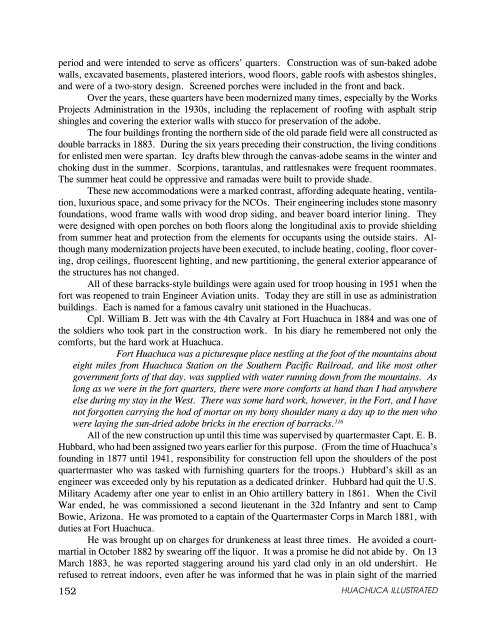Apache Campaigns - Fort Huachuca - U.S. Army
Apache Campaigns - Fort Huachuca - U.S. Army
Apache Campaigns - Fort Huachuca - U.S. Army
Create successful ePaper yourself
Turn your PDF publications into a flip-book with our unique Google optimized e-Paper software.
period and were intended to serve as officers’ quarters. Construction was of sun-baked adobe<br />
walls, excavated basements, plastered interiors, wood floors, gable roofs with asbestos shingles,<br />
and were of a two-story design. Screened porches were included in the front and back.<br />
Over the years, these quarters have been modernized many times, especially by the Works<br />
Projects Administration in the 1930s, including the replacement of roofing with asphalt strip<br />
shingles and covering the exterior walls with stucco for preservation of the adobe.<br />
The four buildings fronting the northern side of the old parade field were all constructed as<br />
double barracks in 1883. During the six years preceding their construction, the living conditions<br />
for enlisted men were spartan. Icy drafts blew through the canvas-adobe seams in the winter and<br />
choking dust in the summer. Scorpions, tarantulas, and rattlesnakes were frequent roommates.<br />
The summer heat could be oppressive and ramadas were built to provide shade.<br />
These new accommodations were a marked contrast, affording adequate heating, ventilation,<br />
luxurious space, and some privacy for the NCOs. Their engineering includes stone masonry<br />
foundations, wood frame walls with wood drop siding, and beaver board interior lining. They<br />
were designed with open porches on both floors along the longitudinal axis to provide shielding<br />
from summer heat and protection from the elements for occupants using the outside stairs. Although<br />
many modernization projects have been executed, to include heating, cooling, floor covering,<br />
drop ceilings, fluorescent lighting, and new partitioning, the general exterior appearance of<br />
the structures has not changed.<br />
All of these barracks-style buildings were again used for troop housing in 1951 when the<br />
fort was reopened to train Engineer Aviation units. Today they are still in use as administration<br />
buildings. Each is named for a famous cavalry unit stationed in the <strong>Huachuca</strong>s.<br />
Cpl. William B. Jett was with the 4th Cavalry at <strong>Fort</strong> <strong>Huachuca</strong> in 1884 and was one of<br />
the soldiers who took part in the construction work. In his diary he remembered not only the<br />
comforts, but the hard work at <strong>Huachuca</strong>.<br />
<strong>Fort</strong> <strong>Huachuca</strong> was a picturesque place nestling at the foot of the mountains about<br />
eight miles from <strong>Huachuca</strong> Station on the Southern Pacific Railroad, and like most other<br />
government forts of that day. was supplied with water running down from the mountains. As<br />
long as we were in the fort quarters, there were more comforts at hand than I had anywhere<br />
else during my stay in the West. There was some hard work, however, in the <strong>Fort</strong>, and I have<br />
not forgotten carrying the hod of mortar on my bony shoulder many a day up to the men who<br />
were laying the sun-dried adobe bricks in the erection of barracks. 116<br />
All of the new construction up until this time was supervised by quartermaster Capt. E. B.<br />
Hubbard, who had been assigned two years earlier for this purpose. (From the time of <strong>Huachuca</strong>’s<br />
founding in 1877 until 1941, responsibility for construction fell upon the shoulders of the post<br />
quartermaster who was tasked with furnishing quarters for the troops.) Hubbard’s skill as an<br />
engineer was exceeded only by his reputation as a dedicated drinker. Hubbard had quit the U.S.<br />
Military Academy after one year to enlist in an Ohio artillery battery in 1861. When the Civil<br />
War ended, he was commissioned a second lieutenant in the 32d Infantry and sent to Camp<br />
Bowie, Arizona. He was promoted to a captain of the Quartermaster Corps in March 1881, with<br />
duties at <strong>Fort</strong> <strong>Huachuca</strong>.<br />
He was brought up on charges for drunkeness at least three times. He avoided a courtmartial<br />
in October 1882 by swearing off the liquor. It was a promise he did not abide by. On 13<br />
March 1883, he was reported staggering around his yard clad only in an old undershirt. He<br />
refused to retreat indoors, even after he was informed that he was in plain sight of the married<br />
152<br />
HUACHUCA ILLUSTRATED

















